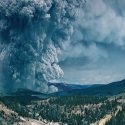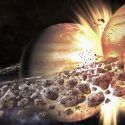Welcome to the Solar System construction zone. Today you’ll be using our cosmic sandbox to build a brand new planet. What would you need to create a rocky planet like Earth? Where should this planet be located to be habitable? And how would this affect the rest of our Solar System?
During the formation of our Solar System, billions of years ago, a giant disc of gas and dust circled our young star. Hydrogen, helium and many other elements swirled. Eventually, gravity lumped these particles together to form planetesimals. This was the first step on their journey to becoming planets.
Eventually, they grew into protoplanets, rocky planets composed of elements with high melting points developed in the hot inner Solar System. And in the outer Solar System, icy gas giants formed. This process occurred over many millions of years. So what would happen if you fast-tracked this planetary construction? Would you be setting up our own planet for destruction?
To get started on the construction project of a lifetime, you’d need certain raw materials. To build a rocky planet like our own, you’d need four key elements that account for 90% of the Earth’s crust. Oxygen would be crucial as it’s the most abundant element on our planet. It makes up 47% of the mass of the crust and 21% of the atmosphere.
The second necessary element would be silicon. This accounts for another 28% of the Earth’s crust. The other two essential elements would be aluminum and iron. With just those four, you could build your rock in space. But if you wanted to spice things up, you could add smaller traces of other elements that make up the crust, like calcium, sodium and magnesium. But now, the hard part would begin.
Since the developing days of our Solar System are long in the past, you’d need an alternative to gas and dust swirling around a protostar. You’d need to follow a more manual plan. In the end, this would be a blessing. If we had a new star developing in our Solar System, it would cause serious gravitational disturbances. Not to mention that temperatures as high as 1,700 °C (3,100 °F) would scorch everything.
So, where would you get all the materials? You could start by mining the asteroid belt located between Mars and Jupiter. But this would be a very small start. Here you’d accumulate only about 4% of the mass of the Moon. If you ventured way out beyond Pluto, you’d be able to accumulate significantly more material in the Oort Cloud.
You’d now have a mass of material equal to about five Earths from the icy, comet-like objects out there. The next step would be to pick the location for your shiny new planet. If you want it to have conditions for life, it would be necessary to place it within the habitable zone. This means the planet would need to orbit our Sun at a distance of 0.9 to 1.2 AU.
So it would be in our planetary neck of the woods. Somewhere between Venus and us or us and Mars. This proximity would have some significant repercussions on Earth. While our planet is primarily impacted by the gravitational pull of the Sun compared to the pull of other planets, this new world would cause some disruptions.
It could shift our orbit and even cause tsunamis or devastating earthquakes. So it would be wise to make a planet smaller than Earth. But just how small it would need to be to avoid catastrophe would still be a gamble. Well, finally, it’s time to get building. And in this case, that would require manually slamming all your collected objects into each other until they fuse.
Pretty easy, right? Not so fast. The other major challenge for you would be time. Planets take at least 10 million years to form naturally. Plus, you’d have to wait for delivery of all that material from the Oort Cloud. Based on the expected 300 years it will take NASA’s Voyager 1 spacecraft to reach this place, you could expect a roundtrip delivery window of at least 600 years.
So much for an easy job. Maybe it would be better not to disrupt billions of years of the delicate balance of our Solar System. Who knows what kind of planetary disruptions a new planet would come with.
Sources
- “Planets And How They Formed”. 2022. lco.global.
- “How Do Planets Form? – Exoplanet Exploration: Planets Beyond Our Solar System”. 2022. exoplanets.nasa.gov.
- “Cultivating A Planetary Garden: How Long Does It Take?”. 2022. jpl.nasa.gov.
- “The Most Abundant Elements In The Earth’s Crust”. Carly Dodd. 2020. worldatlas.com.
- “Atmosphere”. 2019. nationalgeographic.org.



























